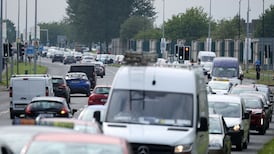The home of Caterina Prosperi (84) wasn't exactly a cathedral.
But like the nearby basilica of St Francis of Assisi, her modest dwelling was wrecked by earthquakes that devastated Italy's Umbria and Marche regions in 1997, killing 11 people.
Now, St Francis's "home", as Franciscan monks call it - the church and burial place that is imbued with his spirit - has been fixed in record time and was reopened to visitors yesterday.
But Ms Prosperi is preparing to spend her third winter in a prefabricated corrugated metal box. She has no idea when she can move back into her house in the devastated village up the road in a mountain area some 40 km from Assisi.
"Before I was a lion," she said, standing outside one of 75 containers in a camp here. "Now I live from day to day."
Ms Prosperi and others among the 10,000 quake victims still living in 35-square-metre containers, similar to trailer homes, ask why the same speed was not applied to rebuilding their homes.
"They should have fixed the houses first," said Mr Sergio Lolli (31), a bricklayer who lives with his 65-year-old mother in container number 29 in the Colfiorito camp.
"What are we going to do, sleep in the basilica?" Mr Lolli asked as he cut wood for the stove. Officials say part of the reason for the reconstruction gap is that Assisi is one construction site while rebuilding thousands of houses to make them earthquake-proof involves many bureaucratic problems that overwhelmed the process.
In an attempt to limit waste, the government allowed people who received reconstruction funds to choose their architects and builders instead of waiting for the state to do it for them.
But demand overwhelmed supply as many people in close-knit communities chose the same trusted architects and builders.
Mr Bruno Bracalenti, president of the Umbria regional government, said about half of the 22,000 people left homeless have either returned to their homes or found subsidised rentals. Some 800 homes with minor damage have been fixed.
There are currently some 4,000 construction sites in the region and another 1,800 are expected to start up soon, he said.
Mr Giuseppe Giulietti, a national parliamentarian of the Democrats of the Left party, said there was no contradiction between the restoration of the basilica and that of the houses.
"This is not just a church reopening. This is also the largest `factory' in Umbria. Three million people a year come here. This means giving merchants, hoteliers and workers a chance to accelerate reconstruction of their houses," he said.
Back at the Colfiorito camp, Mr Dante Amici, who recently found an apartment, rubbed his hands against the evening chill.
"We are happy the basilica has been fixed. We know it's an important economic engine and symbol for the region. But the fact that it has reopened only makes us feel worse," he said.








